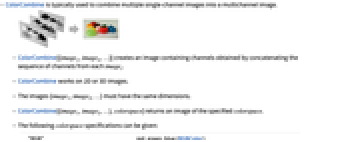ColorCombine[{image1,image2,…}]
creates a multichannel image by combining the sequence of channels in the imagei.
ColorCombine[{image1,image2,…},colorspace]
combines images that represent the color components specified by colorspace.


ColorCombine
ColorCombine[{image1,image2,…}]
creates a multichannel image by combining the sequence of channels in the imagei.
ColorCombine[{image1,image2,…},colorspace]
combines images that represent the color components specified by colorspace.
Details

- ColorCombine is typically used to combine multiple single-channel images into a multichannel image.
- ColorCombine[{image1,image2,…}] creates an image containing channels obtained by concatenating the sequence of channels from each imagei.
- ColorCombine works on 2D or 3D images.
- The images {image1,image2,…} must have the same dimensions.
- ColorCombine[{image1,image2,…},colorspace] returns an image of the specified colorspace.
- The following colorspace specifications can be given:
-
"RGB" red, green, blue (RGBColor) "CMYK" cyan, magenta, yellow, black (CMYKColor) "HSB" hue, saturation, brightness (Hue) "XYZ" CIE XYZ channels (XYZColor) "LAB" CIE Lab channels (LABColor) "LCH" CIE LCH channels (LCHColor) "LUV" CIE LUV channels (LUVColor) - With a colorspace that requires n color channels, n or n+1 channels may be combined. The n+1
 channel is used as an alpha channel.
channel is used as an alpha channel. - When combining a color image with a grayscale image, ColorCombine creates an image of the same color space with alpha channel.

Examples
open all close allBasic Examples (2)
Scope (6)
Combine three binary images into an RGB image:
Combine three single-channel images into an HSB image:
Combine images into a CMYK image:
Color combine channels of a three-channel image rendered using all the supported color spaces:
Combine four single-frame images into an RGBA image:
Combine an RGB image with a single-frame image to get an RGBA image:
Applications (5)
Display a channel-wise GradientFilter:
Increase the contrast of the luminance channel only:
Highlight the result of corner filtering:
Show corners in red by adding the result to the red channel and subtract it from the green and blue channels:
Replace the red channel of an aerial image with an infrared image to highlight regions with greater biomass density:
Add an alpha channel to a 3D image that highlights a single slice:
Add an alpha channel in the shape of a Gaussian sphere to a 3D image:
Properties & Relations (2)
By default, no explicit color space is assigned to the image:
Note that three channel images are rendered similarly to RGB images:
Images created with ColorCombine have Interleaving->False:
Related Guides
Text
Wolfram Research (2008), ColorCombine, Wolfram Language function, https://reference.wolfram.com/language/ref/ColorCombine.html (updated 2012).
CMS
Wolfram Language. 2008. "ColorCombine." Wolfram Language & System Documentation Center. Wolfram Research. Last Modified 2012. https://reference.wolfram.com/language/ref/ColorCombine.html.
APA
Wolfram Language. (2008). ColorCombine. Wolfram Language & System Documentation Center. Retrieved from https://reference.wolfram.com/language/ref/ColorCombine.html
BibTeX
@misc{reference.wolfram_2025_colorcombine, author="Wolfram Research", title="{ColorCombine}", year="2012", howpublished="\url{https://reference.wolfram.com/language/ref/ColorCombine.html}", note=[Accessed: 24-December-2025]}
BibLaTeX
@online{reference.wolfram_2025_colorcombine, organization={Wolfram Research}, title={ColorCombine}, year={2012}, url={https://reference.wolfram.com/language/ref/ColorCombine.html}, note=[Accessed: 24-December-2025]}